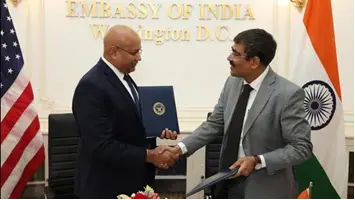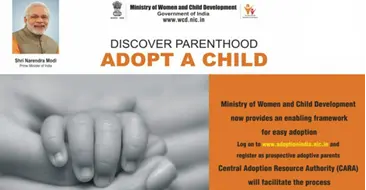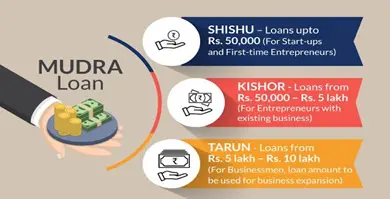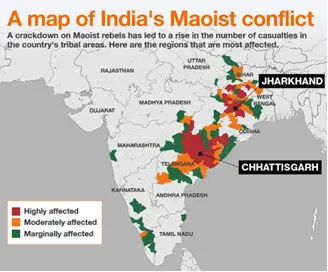Friday, 30th August 2024
Why PM 2.5 pollution dipped in 2022 in India
Why in the news?
- A study by EPIC revealed that improved weather and reduced emissions decreased PM2.5 pollution in India between 2021 and 2022, contributing to a one-year increase in average life expectancy.
- Adhering to WHO pollution guidelines could increase life expectancy in Delhi by 7.8 years.


Key Highlights of the report:
- PM2.5 Reduction in India: Between 2021 and 2022, India saw a 19.3% reduction in PM2.5 pollution, second only to Bangladesh, adding 51 days to the average life expectancy of citizens.
- Impact of Thermal Inversions: The decline in pollution is attributed to favourable weather and fewer thermal inversions, which typically trap pollutants near the ground.
- WHO's PM2.5 Standards: If India fails to meet WHO's PM2.5 guideline of 5 micrograms/m³, citizens could lose 3.6 years of life expectancy.
- Regional Declines: Significant drops in PM2.5 were noted in districts like Purulia (West Bengal) and Dhanbad (Jharkhand), with reductions over 20 micrograms/m³.
- Population in High Pollution Areas: Despite improvements, 42.6% of India's population still lives in areas exceeding the national air quality standard.
- National Clean Air Programme (NCAP): Districts under NCAP saw a 19% reduction in PM2.5, with non-NCAP districts seeing a 16% decline. NCAP targets a 40% reduction in particulate pollution by 2026.
- Innovative Policies: Gujarat's particulate pollution market and the Pradhan Mantri Ujjwala Yojana were praised for reducing pollution and improving public health without hindering economic growth.
Has NCAP Managed to Reduce Pollution?
- The NCAP Tracker, developed by organisations focused on air pollution policy, monitors the progress of the National Clean Air Programme (NCAP) in achieving its 2024 clean air targets.
- Despite Delhi being the most polluted city in 2022, its PM2.5 levels improved by over 7% compared to 2019.
- Most cities in the top 10 polluted list in 2022 were from the Indo-Gangetic Plain.
- Nine of the ten most polluted cities in 2019 saw reductions in PM2.5 and PM10 levels in 2022.
- However, 16 NCAP and 15 non-NCAP cities registered significant increases in PM2.5 levels, indicating similar pollution trends and questioning NCAP's effectiveness.
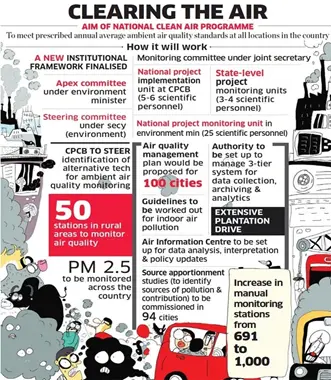
Initiatives Taken for Controlling Air Pollution:
- System of Air Quality and Weather Forecasting and Research (SAFAR): A portal providing real-time air quality data.
- Air Quality Index (AQI): Tracks eight pollutants: PM2.5, PM10, ammonia, lead, nitrogen oxides, sulfur dioxide, ozone, and carbon monoxide.
- Graded Response Action Plan (Delhi): A plan to reduce pollution in Delhi based on severity.
- Reducing Vehicular Pollution:
- BS-VI Vehicles: Stricter emission norms.
- Electric Vehicles (EVs): Promoting EVs to reduce vehicular emissions.
- Odd-Even Policy: Implemented in Delhi as an emergency measure.
- New Commission for Air Quality Management: Overseeing air quality management efforts.
- Subsidy for Turbo Happy Seeder (THS): Provided to farmers to reduce stubble burning.
- National Air Quality Monitoring Programme (NAMP): Monitors four pollutants—SO2, NO2, PM10, and PM2.5—across various locations.
|
UPSC Civil Services Examination Previous Year Question (PYQ) Prelims Q:1 In the cities of our country, which among the following atmospheric gases are normally considered in calculating the value of the Air Quality Index? (2016)
Select the correct answer using the code given below:
Ans: (b)
Mains Q:1 Describe the key points of the revised Global Air Quality Guidelines (AQGs) recently released by the World Health Organisation (WHO). How are these different from its last update in 2005? What changes in India’s National Clean Air Programme are required to achieve revised standards? (2021) |
Source: HT
The Gender Budget of 2024-25
Why in the news?
- In the 2024-25 Budget, the finance minister emphasised women-led development, underscoring a commitment to women's empowerment.
- The Gender Budget has reached 1% of GDP for the first time, with allocations for pro-women programs exceeding ₹3 lakh crore, signalling a significant investment in gender equality initiatives.
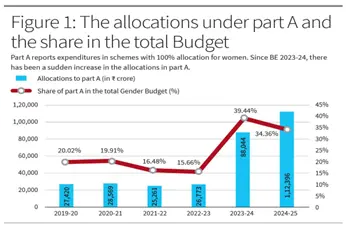
Gender Budget in India
- About
- Definition: Gender budgeting is a policy strategy that integrates a gender perspective into budget processes.
- Purpose: It aims to ensure that public resources are distributed equitably across genders by assessing how government spending impacts men and women differently.
- Goal: The primary goal is to promote gender equality through gender-sensitive formulation, resource allocation, and monitoring of policies.
- Need for Gender Budgeting
- Persistent Disparities: Despite India's progress, significant gender disparities exist in areas such as education, health, employment, and political participation.
- Addressing Gaps: Gender budgeting is essential to address these disparities, ensuring that women's specific needs are considered in policy formulation and implementation.
- Accountability: It promotes accountability by aligning government spending with gender equality goals.
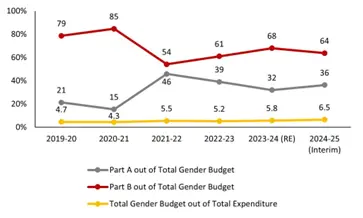
- Introduction of Gender Budgeting in India
- Initiation: India introduced gender budgeting in 2005-06, spearheaded by the Ministry of Women and Child Development with support from the Ministry of Finance.
- Classification of Budget Allocations:
- Part A: Schemes with 100% of the budget allocated for women.
- Part B: Schemes where at least 30% of the budget is allocated for women.
- Part C: Schemes with up to 30% of their funds allocated to women.
- Implementation of Gender Budgeting
- Nodal Authorities: Implementation is led by the Ministry of Women and Child Development at the central level.
- State and Union Territories: Departments of Women and Child Development/Social Welfare, Finance, or Planning in states and Union territories are responsible for local implementation.
The Gender Budget (GB) of 2024-25:
- About
- GDP Estimate: In 2024-25, the Gender Budget reached 1% of GDP estimates for the first time.
- Total Allocation: Over ₹3 lakh crore has been allocated for pro-women programs.
- Budget Share: The Gender Budget Statement (GBS) now accounts for 6.8% of the total budget, up from an average of 5% since its introduction.
- Increase Driven by Two Main Factors
- Introduction of Part C:
- Category: Includes schemes with less than 30% allocation for women.
- Example: The PM Kisan scheme now reports ₹15,000 crore, or 25% of its total outlay, under this category.
- Rise in Part A Allocations:
- Coverage: Schemes with 100% allocation for women.
- Impact: Part A allocations surged from 15-17% to nearly 40% of GBS allocations, largely due to the reclassification of the Pradhan Mantri Awas Yojana (PMAY) from Part B to Part A.
- Introduction of Part C:
- Issues of Over-reporting and Under-reporting
- Over-reporting:
- Example: The PM Employment Generation Programme (PMEGP) reported 40% of its ₹920 crore allocation for women without clear justification.
- Over-reporting:
- Under-reporting:
- Example: The National Rural Livelihoods Mission (NRLM) was previously unreported but is now correctly reflected with 100% allocation for women in Part A.
- Discrepancy: MGNREGS reflects only 33.6% of its budget for women in Part B, despite women constituting 59.3% of all person-days under the scheme.
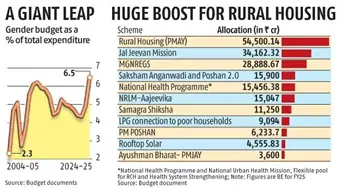
Way Forward:
- Addressing Reporting Anomalies:
- Incorporating Explanations: Providing detailed explanations for GBS entries would enhance accuracy, aid in gender audits, and ensure better gender outcomes in government programs.
- Scientific Approach: The inclusion of Part C reflects progress in reporting, but the GBS still requires a more systematic and scientific approach to minimise anomalies.
- Improving GBS Quality:
- Efforts and Challenges: While efforts to reduce misreporting are evident, further improvements are necessary to ensure that gender-responsive budgeting accurately reflects actual spending for women.
- Rationale for Detailed Reporting: Detailed reporting should focus on ensuring that allocations truly address women’s needs, closing gender gaps through well-planned and inclusive government programs.
Source: TH
Himachal Bill raises women’s marriage age
Why in the news?
- The Himachal Pradesh Assembly has recently passed the Prohibition of Child Marriage (Himachal Pradesh Amendment) Bill, 2024, proposing to raise the minimum age of marriage for women from 18 to 21 years.
- This amendment updates the Prohibition of Child Marriage (PCM) Act of 2006.

Debate Surrounding the Minimum Age for Marriage for Girls:
- Gender Equality and Education:
- Higher Education:
- Opportunity for Advanced Education: Extending the marriage age allows girls additional time to complete higher education, enhancing their career prospects and reducing gender disparities in education.
- Skill Development: Delayed marriage provides women with opportunities to acquire advanced skills and pursue professional growth.
- Empowerment:
- Financial Independence: By delaying marriage, women can gain financial independence and contribute to economic development.
- Higher Education:
- Health and Well-being:
- Maternal Health:
- Reduced Risks of Complications: Delaying marriage decreases the likelihood of early pregnancies, associated with risks like maternal and infant mortality.
- Improved Health Outcomes: Matured individuals are better prepared for the physical and emotional demands of pregnancy.
- Child Development:
- Enhanced Child Rearing: Postponed motherhood allows women to provide better care, ensuring better developmental outcomes for children.
- Maternal Health:
- Reducing Child Marriage:
- Combatting Persistent Issues:
- Social Challenges: Early marriages lead to domestic violence, educational deprivation, and perpetuate poverty, which the Bill aims to address.
- Legal and Social Reforms: Strengthening laws and promoting education can combat the prevalence of child marriages.
- Combatting Persistent Issues:
- Economic Development:
- Workforce Participation:
- Increased Economic Contributions: Delaying marriage can lead to higher female participation in the workforce, fostering economic growth.
- Economic Benefits: A more educated and skilled female workforce contributes significantly to national economic development.
- Workforce Participation:
Key Challenges:
- Different Age for Attaining Majority and Marriage:
- Discrepancy in Rights and Responsibilities:
- Legal Inconsistency: The Bill raises the marriage age to 21, but the age of majority remains 18 under the Majority Act, 1875, creating potential legal conflicts and uncertainties for individuals aged 18 to 21.
- Impact on Legal Status: This discrepancy may affect individuals' rights and responsibilities during the transitional period.
- Discrepancy in Rights and Responsibilities:
- Inconsistencies with Supreme Court Judgements:
- Constitutional Challenges:
- Right to Marry: Supreme Court judgments in 2018 affirmed that the right to marry is part of the fundamental right to life under Article 21, which may conflict with the Bill’s age restriction.
- Choice of Partners: Court decisions also emphasise the right of adults to consensually choose partners, raising questions about the Bill’s restrictions.
- Constitutional Challenges:
- Implementation Challenges:
- Detection and Enforcement:
- Limited Effectiveness: The detection of marriages under 18 has been low, with only 785 cases registered in 2020, questioning the Bill’s effectiveness in reducing child marriages.
- Practical Concerns: Increased age requirements may face challenges in enforcement and impact.
- Detection and Enforcement:
Himachal Bill to Raise Women’s Marriage Age:
- Unified Marriage Age: The Bill amends the PCM Act to set the minimum marriage age at 21 for both genders, eliminating previous distinctions.
- Definition of a Child: It defines "child" as anyone under 21, overriding other laws or cultural practices allowing earlier marriage.
- Annulment Period: The Bill extends the period for filing annulment petitions to five years after reaching the age of majority, providing individuals until age 23 to annul a marriage.
Legislative Process and Constitutional Implications:
- Conflict with Central Law:
- The Bill’s proposal to raise the marriage age to 21 conflicts with the central law setting it at 18.
- As marriage falls under the Concurrent List, both central and state governments can legislate, but conflicts must be resolved.
- President’s Assent Required:
- Under Article 254(1) of the Constitution, state laws conflicting with central laws are void unless the President provides assent under Article 254(2).
- The Bill requires the President’s assent to become law, akin to the process for Uttarakhand’s Uniform Civil Code (UCC) Bill
Source: TH
National Industrial Corridor Development Programme (NICDP)
Why in the news?
- The CCEA, led by the Prime Minister, sanctioned the development of 12 "industrial smart cities" across 10 states with a planned investment of Rs 28,602 crore.
- This decision follows the Finance Minister's Union Budget 2024-25 announcement, detailing the sanction of 12 industrial parks under the National Industrial Corridor Development Programme (NICDP).

About the Industrial Parks Projects:
- Objective: Establish a network of 12 industrial parks to enhance economic growth and global competitiveness.
- Investment: ₹28,602 crore approved for the development of these parks.
- Time Frame: Expected completion within three years.
- Aim: To drive balanced regional development with robust infrastructure.
- Coverage Regions:
- Khurpia (Uttarakhand)
- Rajpura-Patiala (Punjab)
- Dighi (Maharashtra)
- Palakkad (Kerala)
- Agra and Prayagraj (Uttar Pradesh)
- Gaya (Bihar)
- Zaheerabad (Telangana)
- Orvakal and Kopparthy (Andhra Pradesh)
- Jodhpur-Pali (Rajasthan)
- One city’s name withheld due to the Model Code of Conduct in poll-bound states.
- Industrial Corridors Included:
- Vizag-Chennai
- Hyderabad-Bengaluru
- Hyderabad-Nagpur
- Chennai-Bengaluru
- Coverage Parks:
- 2,600 acres in Kopparthy and Orvakal (Andhra Pradesh)
- 3,245 acres in Zaheerabad (Telangana)
- 1,710 acres in Palakkad (Kerala)
- Existing Projects:
- Completed: Dholera (Gujarat), Auric (Maharashtra), Vikram Udyogpuri (Madhya Pradesh), Krishnapatnam (Andhra Pradesh)
- Under Implementation: Tumakuru (Karnataka), Krishnapatnam (Andhra Pradesh), Nangal Chaudhary (Haryana), Dadri-Greater Noida (Uttar Pradesh)
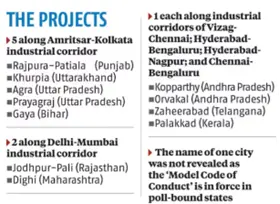
Other Projects Approved by CCEA
- Railway Projects:
- Approval: Three railway projects and two new railway lines with a total estimated cost of ₹6,456 crore.
- Coverage: Projects span 7 districts across Odisha, Jharkhand, West Bengal, and Chhattisgarh.
- Impact: Adds about 300 km to the existing network, enhancing logistical efficiency, connecting previously unlinked areas, increasing line capacity, and boosting economic growth through improved transportation.
- Hydropower Projects:
- Approval: Equity support of ₹4,136 crore for northeastern states to develop hydropower projects with a total capacity of 15,000 MW over the next eight years.
- Equity Participation: Funds will support joint ventures between northeastern state entities and central public sector developers.
- Implementation: Central assistance to be utilised by April 2032, with a 10% gross budgetary support from the power ministry's total outlay.
- Significance: Aims to facilitate state government participation, mitigate risks, and address land acquisition and local issues, contributing to the country’s climate commitments.
About Industrial Parks:
- Definition: Industrial parks are designated areas planned specifically for industrial development.
- Examples: Dholera SEZ (Gujarat), Adani Mundra SEZ.
- Significance:
- Productivity and Competitiveness: Boost job creation and infrastructure sharing, enhancing productivity.
- Growth and Development: Attract FDI, stimulate manufacturing, and provide integrated infrastructure and cost savings.
- Benefits: Contribute to regional economic growth, business expansion, and environmental controls.
Key Highlights of Recently Announced 12 Industrial Parks:
- Strategic Investments: NICDP aims to build a vibrant industrial ecosystem with investments from large industries and MSMEs.
- Smart Cities and Infrastructure: New cities will feature modern, greenfield smart city concepts with "plug-n-play" and "walk-to-work" facilities.
- Area Approach: Aligns with PM Gati Shakti for multi-modal connectivity to ensure seamless movement of goods and services.
- Vision for Viksit Bharat: Develop land for immediate allotment to boost India’s role in Global Value Chains and support Atma Nirbhar Bharat.
- Commitment to Sustainability: Incorporates ICT-enabled utilities and green technologies to minimise environmental impact.
Significance of the Recently Announced 12 Industrial Parks:
- Growth: Advanced infrastructure to enhance manufacturing capabilities and economic growth.
- Development: Expected to attract ₹1.5 lakh crore in investments, creating up to 4 million jobs and aiding socio-economic upliftment.
- Catalyst for Target: Aims to achieve $2 trillion in exports by 2030 and strengthen India's role in global value chains.
- Enhancement in GVC: Supports Viksit Bharat and Atmanirbhar Bharat visions with ready-to-allot land for investors.
Challenges in Implementation:
- Infrastructure Development: Balancing infrastructure provision with industrial growth.
- Regulatory Hurdles: Navigating bureaucratic procedures and regulations.
- Land Acquisition: Securing land amid disputes and environmental concerns.
- Negative Spillovers: Addressing pollution, traffic congestion, and resource strain.
- Skill Shortages: Finding and retaining a skilled workforce.
- Underutilisation: Some parks may remain underutilised due to various factors.
- Impact on Local Communities: Managing displacement, livelihood changes, and environmental impacts.
Way Forward:
- Investment in Infrastructure: Prioritise projects like the DFC and Bharatmala to improve logistics.
- Establishment of Smart Zones: Develop SEZs with integrated infrastructure to attract manufacturing.
- Enhancement of Human Skilling: Expand initiatives like Skill India Mission for vocational training.
- Adoption of Industry 4.0: Incentivize automation and digital technologies through schemes like PLI.
- Focus on Green Manufacturing: Encourage eco-friendly practices and compliance with global standards.
Conclusion
The approval of 12 new industrial nodes under the NICDP represents a crucial step in transforming India's industrial landscape. With a focus on integrated development, modern infrastructure, and sustainability, these projects aim to drive economic growth and position India as a global manufacturing leader.
Source: IE
Centre Redesigns Agricultural Infrastructure Fund to Cover
Why in the news?
- Recently, the Union Cabinet has expanded the scope of the Agricultural Infrastructure Fund (AIF).
- This ₹1 lakh crore scheme will now include financial support for Farmers’ Producers Organisations (FPOs) to enhance their financial stability and creditworthiness.
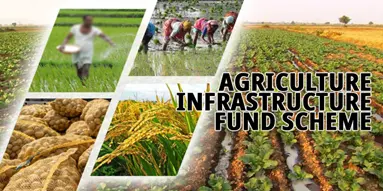
About Agricultural Infrastructure Fund (AIF):
- Launch: Initiated by the Government of India in July 2020 under the Atmanirbhar Bharat Abhiyan.
- Objective: To provide financial support for creating and modernising agricultural infrastructure, thereby improving sector efficiency.
Key Features of the Agricultural Infrastructure Fund:
- Financial Support:
- Provides medium to long-term debt financing for post-harvest management infrastructure and community farming assets.
- Allocates ₹1 lakh crore through banks and financial institutions until 2025-26.
- Interest Subvention:
- Offers a 3% per annum interest subvention on loans up to ₹2 crore for up to seven years.
- Credit Guarantee:
- Coverage is provided through the Credit Guarantee Fund Trust for Micro and Small Enterprises (CGTMSE), reducing lending risks for institutions.
- Eligible Entities:
- Accessible to farmers, Primary Agricultural Credit Societies (PACS), FPOs, Self Help Groups (SHGs), and agricultural entrepreneurs.
- Infrastructure Development:
- Supports critical infrastructure such as cold storage, warehouses, grading and sorting units, and processing facilities.
- Encourages development of community farming assets, including organic input units, custom hiring centres, and renewable energy assets.
- Digital Integration:
- Integrated with digital platforms like e-NAM for better market access and reduced supply chain inefficiencies.
Benefits of the Agricultural Infrastructure Fund:
- Reduction of Post-Harvest Losses: Enhances storage and processing facilities to minimise post-harvest losses.
- Increased Farmers’ Income: Improves income by reducing waste and enhancing the value of produce through better infrastructure and market access.
- Rural Employment: Generates rural jobs, contributing to economic development in rural areas.
- Sustainable Agriculture: Promotes sustainable practices with modern infrastructure.
What is a Farmer Producer Organization (FPO)?
- Definition: A legal entity formed by primary producers like farmers, milk producers, fishermen, etc.
- Objective: To improve income through collective organisation.
- Ownership: Owned and managed by its members, focusing on better income and development for producers.
- FPO Role: Provides education and training to its members and staff to enhance their contributions.
Centre Redesigns Agricultural Infrastructure Fund to Cover FPOs:
- Expansion: The Union Cabinet has redesigned the AIF to include financial support for FPOs, aiming to boost their financial stability and creditworthiness.
- Impact: The expanded scheme will enhance agricultural infrastructure and make the fund more inclusive.
- Current Status: ₹47,575 crore has been sanctioned for 74,508 projects under AIF, with a total investment of ₹78,596 crore, including ₹78,433 crore from private entities.
- Employment: The projects have created over 8.19 lakh rural jobs.
- Future Outlook: The expanded AIF is expected to further drive agricultural growth, improve productivity, increase farm incomes, and support sustainability in Indian agriculture.
|
UPSC Civil Services Examination, Previous Year Question (PYQ) Prelims Q.1 How is permaculture farming different from conventional chemical farming? (2021)
Select the correct answer using the code given below.
Ans: (b)
Q:2 With reference to ‘National Investment and Infrastructure Fund’, which of the following statements is/are correct?
Select the correct answer using the codes given below:
Answer: D
Q:3 Which of the following is the chief characteristic of ‘mixed farming’? (2012)
Ans: (c)
Q:4 With reference to micro-irrigation, which of the following statements is/are correct? (2011)
Select the correct answer using the codes given below:
Ans: (c)
Mains Q:1 What are the present challenges before crop diversification? How do emerging technologies provide an opportunity for crop diversification? (2021) |
Source: TH
Leptospirosis
Why in the news?
- Kerala recently saw relief from a potential Nipah virus outbreak, with no new cases during the critical 42-day observation period.
- However, a surge in Leptospirosis, or "rat fever," has emerged as a significant public health concern, particularly after the monsoons.
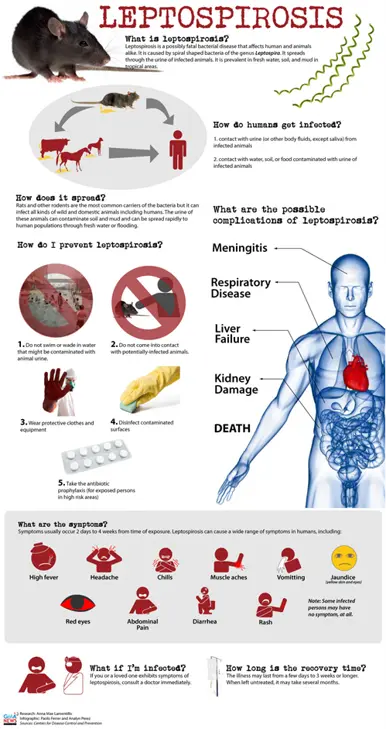
Key Facts About Leptospirosis
- Cause:
- Leptospirosis is a zoonotic bacterial infection caused by Leptospira spirochaetes.
- These bacteria are primarily found in the kidneys and genital tracts of animals like rodents, cattle, pigs, and dogs, which are the main sources of human infection.
- Reservoirs:
- Many mammals can harbour leptospires, particularly rodents, which can excrete the bacteria throughout their lives without symptoms, making them major reservoirs.
- Infected animals often carry the bacteria asymptomatically but may fall ill if infected by a different serovar.
- Transmission:
- The disease is transmitted via direct contact with the urine of infected animals or indirectly through contaminated water, soil, or food.
- Leptospires enter the human body through cuts, mucous membranes, or waterlogged skin, with rare human-to-human transmission.
- Symptoms:
- Leptospirosis ranges from mild flu-like symptoms to severe conditions like Weil's syndrome, meningitis, and pulmonary haemorrhage.
- The incubation period is 7-10 days, with common symptoms including fever, headache, and jaundice.
- It is often underdiagnosed due to its symptom diversity and limited diagnostic access.
- Epidemiology:
- Leptospirosis is most common in tropical and subtropical regions with high rainfall.
- South-East Asia, including India, Indonesia, Thailand, and Sri Lanka, reports the most cases, especially during the rainy season.
- High-risk groups include farmers, veterinarians, and sewer workers.
- Prevention:
- Preventive measures include controlling animal reservoirs, avoiding contact with contaminated environments, wearing protective gear, and maintaining sanitation.
- Vaccination of animals like dogs, pigs, and cattle with serovar-specific vaccines helps but may not eliminate renal carriage.
- Treatment:
- Treated with antibiotics such as penicillin G, doxycycline, and ceftriaxone.
- Early treatment is critical to avoid severe complications.
- India's Initiatives on Leptospirosis
- Prevention Programme: Launched during the 12th Five-Year Plan to reduce leptospirosis-related deaths and illnesses.
- One Health Approach: Integrates human, animal, and environmental health for effective disease management and prevention.
- Common Monsoon Infections in India
- Infections: Monsoon triggers a rise in diseases like Dengue, Malaria, Cholera, Typhoid, and Flu due to waterlogging, increasing the risk of dehydration and mosquito-borne diseases.
|
UPSC Civil Services Examination, Previous Year Questions (PYQs) Prelims Q:1 Consider the following statements: (2017)
Which of the statements given above is/are correct?
Ans: (c) |
The Agriculture Infrastructure Fund (AIF) Scheme
Why in the news?
- Recently, the Central Government expanded the scope of the Agricultural Infrastructure Fund (AIF) scheme to make it more attractive, as part of its objective to strengthen farm-related infrastructure facilities in the country.
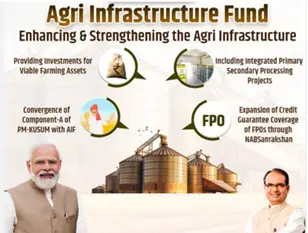
Agriculture Infrastructure Fund (AIF) Scheme:
- Launch & Objective:
- Launched in 2020 as a Central Sector Scheme.
- Aims to provide medium- to long-term debt financing for post-harvest management infrastructure and community farming assets through interest subvention and financial support.
- Scheme duration: FY 2020 to FY 2032 (10 years).
- Eligibility:
- Open to Primary Agricultural Credit Societies (PACS), Marketing Cooperative Societies, Farmer Producer Organizations (FPOs), Farmers, Self Help Groups (SHGs), Joint Liability Groups (JLGs), Multipurpose Cooperative Societies, Agri-entrepreneurs, Startups, and PPP projects by Central/State agencies or Local Bodies.
- Public Sector Undertakings (PSUs) are excluded unless involved in PPP projects.
- Financing participation is open to scheduled commercial banks, cooperative banks, Regional Rural Banks (RRBs), Small Finance Banks, NBFCs, and NCDC.
- NABARD may offer refinance support as needed.
- Key Features:
- Interest subvention of 3% per annum on loans up to ₹2 crores, for a maximum of 7 years.
- Up to 25 projects per applicant in different locations, each eligible for loans up to ₹2 crores (not applicable to state agencies, cooperatives, federations of FPOs/SHGs).
- Mandatory borrower contribution of at least 10% of the project cost.
- Moratorium for repayment: 6 months to 2 years.
- 24% of grants to be utilised for SC/ST entrepreneurs (16% for SC, 8% for ST).
- Priority loan coverage for women and weaker sections.
- Credit guarantee coverage under CGTMSE for loans up to ₹2 crores, with the fee paid by the government.
- FPOs can avail credit guarantees from the FPO promotion scheme by DACFW.
|
UPSC Civil Services Examination, Previous Year Question (PYQ) Prelims Q.1 How is permaculture farming different from conventional chemical farming? (2021)
Select the correct answer using the code given below.
Ans: (b)
Q.2 Which of the following is the chief characteristic of ‘mixed farming’? (2012)
Ans: (c)
Q.3 With reference to micro-irrigation, which of the following statements is/are correct? (2011)
Select the correct answer using the codes given below:
Ans: (c)
Mains Q.1 What are the present challenges before crop diversification? How do emerging technologies provide an opportunity for crop diversification? (2021) |
Source: BS
ANUBHAV Awards
Why in the news?
- The Department of Pension and Pensioners’ Welfare (DoPPW) recently organised the 7th Anubhav Awards ceremony to recognize the contributions of Central Government employees during their service.
- Secretary, Department of Pension & Pensioners’ Welfare, Shri V. Srinivas inaugurated 55th Pre-Retirement Counselling (PRC) Workshop.
- More than 750 Central Government / CAPFs Retirees participated in PRC
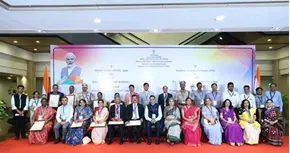
What are the ANUBHAV Awards?
- About:
- The ANUBHAV Awards acknowledge the contributions of retired officials to nation-building during their tenure in government service and aim to document India's administrative history through written narratives.
- The ANUBHAV Portal, launched in March 2015 by the Department of Pension & Pensioners’ Welfare under the Union Ministry of Personnel, Public Grievances & Pensions, serves as an online platform for retiring and retired government employees to share their experiences.
- Objectives:
- The initiative seeks to create a database of significant suggestions and work experiences.
- It harnesses the human resource potential of retiring employees for nation-building.
- It encourages Ministries/Departments to consider useful and replicable suggestions for implementing crucial steps.
- Eligibility:
- Retiring Central Government employees/pensioners are eligible to participate by submitting their Anubhav write-ups eight months before retirement and up to one year after retirement.
- The submitted write-ups are published after evaluation by the concerned Ministries/Departments. Published write-ups are then shortlisted for ANUBHAV Awards and Jury Certificates.
- Awards:
- Each ANUBHAV Awardee receives a medal, certificate, and a cash prize of INR 10,000, while Jury Certificate Winners are presented with a medal and certificate.
|
UPSC Civil Services Examination PYQ Prelims Q:1 Consider the following statements in respect of Bharat Ratna and Padma Awards:[2021]
Which of the above statements are not correct?
Answer: D |
Source: PIB
National Teachers’ Award
Why in the news?
- The Department of Higher Education, under the Union Ministry of Education, has recently selected 16 teachers from Higher Education Institutions (HEIs) and Polytechnics for the National Awards to Teachers (NAT) 2024.
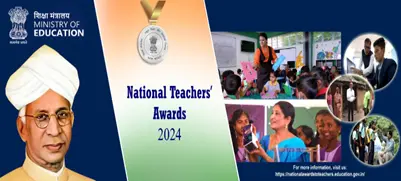
National Teachers’ Award:
- About:
- The award aims to celebrate the exceptional contributions of some of the finest teachers in the country.
- It honours educators who have significantly enhanced the quality of education and enriched the lives of their students through dedication and hard work.
- This recognition is specifically conferred on exemplary teachers and faculty members in higher education institutions and Polytechnics.
- Category:
- Sub-category (i): Teachers of Higher Educational Institutions Engineering & Technology, Architecture.
- Sub-category (ii): Pure Sciences including Mathematics, Physical Sciences, Biological Sciences, Chemical Sciences, Medicine, Pharmacy
- Sub-category (iii): Arts and Social Sciences, Humanities, Languages, Legal Studies, Commerce, Management.
- Eligibility:
- The award is open to all faculty members in colleges, universities, higher educational institutions, and Polytechnics across India.
- Nominees must be regular faculty members with at least five years of full-time experience at the undergraduate or postgraduate level.
- The nominee should be under 55 years of age as of the last date for submitting applications.
- Vice-Chancellors, Directors, and Principals (whether regular or officiating) are not eligible.
- However, individuals who have held such positions, are below 55 years of age, and remain in active service are eligible.
- Awards:
- Winners of the National Teachers’ Award receive a medal, a certificate, and a cash prize of INR 50,000.
Source: PIB
Establishing India’s carbon market
Context:
- India, the world's third-largest emitter, faces the challenge of balancing climate goals with developmental needs.
- The Finance Minister's recent policy shift from energy efficiency targets to emission targets for "hard to abate" industries is a key change, addressing the limitations of the Perform, Achieve, and Trade (PAT) scheme.
- This transition towards an Indian Carbon Market signifies India's commitment to exploring market-based emission reduction solutions, despite not having mandatory reduction obligations under its Nationally Determined Contributions (NDCs).
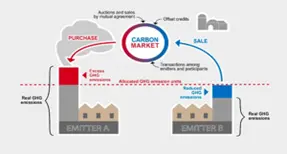
What is the Carbon Market?
- About:
- Carbon markets are designed to reduce greenhouse gas emissions by providing financial incentives for emission reductions.
- They operate on a cap-and-trade principle, where a regulatory authority sets a cap on the total allowable emissions within a specific jurisdiction.
- Types of Carbon Markets:
- Compliance Markets: Mandatory markets where regulated entities must purchase carbon credits to offset their emissions. These typically involve large industrial polluters.
- Voluntary Markets: Optional markets allowing individuals, businesses, and organisations to buy carbon credits to offset emissions beyond regulatory requirements.
- India's Role:
- India plays a significant role in the decentralised voluntary carbon market, exporting credits valued between USD 200-300 billion annually and accounting for 17% of the global supply in 2022.
- Carbon Credits:
- Carbon credits represent a reduction or avoidance of one ton of CO2 equivalent emissions and can be traded.
- They are generated through activities such as implementing energy-efficient technologies, reducing waste, transitioning to renewable energy, and promoting reforestation.
- Carbon Taxes:
- Carbon taxes are direct levies on greenhouse gas emissions, requiring polluters to pay based on their emission levels.
- The revenue generated from these taxes can be used for climate mitigation and adaptation projects or to reduce other taxes.
- Global Trends:
- As of August 2023, there are 74 carbon pricing mechanisms worldwide, including carbon taxes and emissions trading schemes.
- In 2023, carbon pricing revenues reached a record USD 104 billion, according to the World Bank’s “State and Trends of Carbon Pricing 2024” report.

Advantages of Implementing a Carbon Tax
- Incentivizing Green Innovation:
- A carbon tax promotes green innovation by financially encouraging businesses to reduce carbon emissions.
- In India, it could advance solar, wind, and energy storage technologies, similar to British Columbia’s 6.1% emission reduction after its carbon tax.
- This could drive India toward a leadership role in clean tech.
- Revenue Generation for Climate Adaptation:
- Carbon taxes can generate significant revenue for climate adaptation efforts. For India, this could be critical given severe climate impacts.
- The IMF estimates a USD 35 per ton tax could raise 1-2% of GDP by 2030, funding flood protection and drought-resistant agriculture.
- Improving Public Health:
- Reducing fossil fuel use through a carbon tax can improve air quality and public health.
- A USD 50 per ton tax in G20 countries could prevent 600,000 premature deaths annually by 2030, offering economic benefits through reduced healthcare costs and increased productivity.
- Consumption Consciousness:
- Carbon taxes can raise awareness about the carbon footprint of products, influencing consumer behaviour.
- In India, this could shift consumers toward sustainable choices by increasing the cost of carbon-intensive goods, thereby accelerating the transition to a low-carbon economy.
Major Challenges Related to Carbon Taxation in India
- Economic Impact on Industries:
- A carbon tax could raise production costs for energy-intensive industries like steel and cement, potentially affecting global competitiveness.
- Careful policy design is needed to balance environmental benefits with economic impacts.
- Regressive Nature - Burden on Lower-Income Groups:
- Carbon taxes can disproportionately impact lower-income groups who spend more on energy.
- With India’s large poor population, a poorly designed tax might increase costs for essential services, exacerbating economic inequality.
- Limited Scope:
- Carbon taxes primarily target CO2 emissions but may not address other greenhouse gases like methane, which has a higher warming potential.
- The Informal Sector Conundrum:
- India’s informal sector poses challenges for carbon tax implementation due to difficulties in tracking and taxing emissions from small, unregistered businesses.
- Inter-State Disparities and Carbon Leakage:
- A national carbon tax might unevenly affect states with different industrialization levels and energy mixes.
- Additionally, carbon leakage could occur if emissions-intensive industries move to regions with looser regulations.
Measures India Can Adopt for Effective Carbon Market Establishment
- Phased Implementation:
- Introduce carbon taxation gradually, starting with a low rate and increasing it over time. This phased approach helps industries adapt and invest in cleaner technologies while developing supporting infrastructure.
- Border Carbon Adjustments:
- Implement border carbon adjustments (BCAs) to impose carbon prices on imports based on their emissions, protecting domestic industries and aligning with WTO regulations.
- Technology Transfer Incentives:
- Use carbon tax revenue to fund a "Clean Tech Adoption Fund" for low-interest loans or grants, supporting SME investments in green technologies.
- Green Lanes for Industries:
- Create a tiered regulatory system offering expedited approvals and incentives for industries with significant carbon reduction efforts, promoting cleaner practices.
- Carbon Credit Cooperative for SMEs:
- Establish a cooperative framework for SMEs to pool emissions reduction efforts, generate carbon credits, and broaden market participation.
- Carbon Tech Incubators:
- Launch incubators to support startups developing indigenous carbon reduction technologies, providing funding, mentorship, and facilities.
- Green Finance Revolution:
- Develop a green finance ecosystem with green bonds and climate risk insurance and create a national green investment bank to attract private investment.
- Integration with Existing Schemes:
- Integrate the new carbon market with existing schemes like PAT and REC, develop conversion mechanisms, and establish a common trading platform for coherence and liquidity.
Conclusion
India stands at a critical juncture in its journey toward balancing climate goals with economic growth. Establishing a well-designed carbon market, integrating existing schemes, and fostering innovation will enable India to lead in sustainable development. By taking decisive action now, India can drive the transition to a low-carbon future and emerge as a global leader in creating a resilient, climate-conscious economy.
|
UPSC Civil Services Examination, Previous Year Question (PYQ) Prelims Q:1 Consider the following statements (2023) Statement—I Carbon markets are likely to be one of the most widespread tools in the fight against climate change. Statement—II Carbon markets transfer resources from the private sector to the State.
Which one of the following is correct in respect of the above statements?
Ans: B
Q:2 The concept of carbon credit originated from which one of the following? (2009)
Ans: B |
Source: TH
Share the article
Edukemy’s Current Affairs Quiz is published with multiple choice questions for UPSC exams
MCQ
Get Latest Updates on Offers, Event dates, and free Mentorship sessions.

Get in touch with our Expert Academic Counsellors 👋
FAQs
UPSC Daily Current Affairs focuses on learning current events on a daily basis. An aspirant needs to study regular and updated information about current events, news, and relevant topics that are important for UPSC aspirants. It covers national and international affairs, government policies, socio-economic issues, science and technology advancements, and more.
UPSC Daily Current Affairs provides aspirants with a concise and comprehensive overview of the latest happenings and developments across various fields. It helps aspirants stay updated with current affairs and provides them with valuable insights and analysis, which are essential for answering questions in the UPSC examinations. It enhances their knowledge, analytical skills, and ability to connect current affairs with the UPSC syllabus.
UPSC Daily Current Affairs covers a wide range of topics, including politics, economics, science and technology, environment, social issues, governance, international relations, and more. It offers news summaries, in-depth analyses, editorials, opinion pieces, and relevant study materials. It also provides practice questions and quizzes to help aspirants test their understanding of current affairs.
Edukemy's UPSC Daily Current Affairs can be accessed through:
- UPSC Daily Current Affairs can be accessed through Current Affairs tab at the top of the Main Page of Edukemy.
- Edukemy Mobile app: The Daily Current Affairs can also be access through Edukemy Mobile App.
- Social media: Follow Edukemy’s official social media accounts or pages that provide UPSC Daily Current Affairs updates, including Facebook, Twitter, or Telegram channels.

